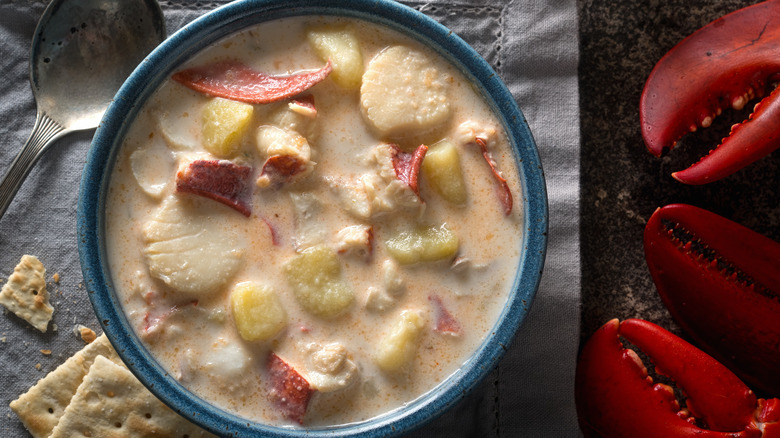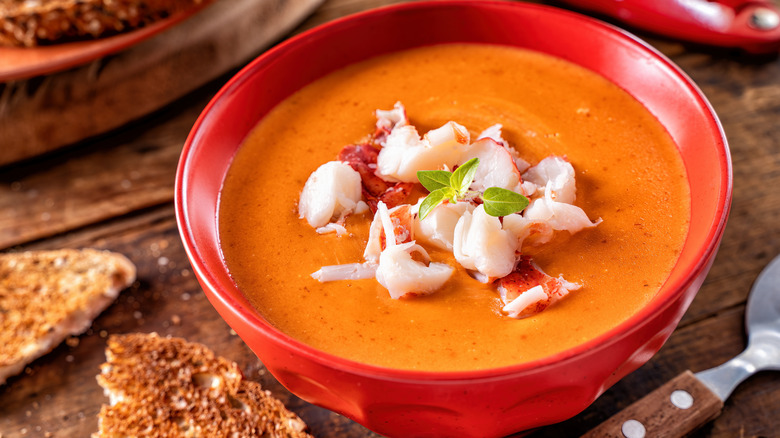What's The Difference Between Chowder And Bisque?
A fresh sardine thrown straight on the grill is a spectacular sight of summertime seaside cuisine, but simple fish preparations can be somewhat seasonal and require specific types of fish. Seafood soups, on the other hand, are a hit all year round and have been consumed for centuries. Packed full of flavor, these soups can be made under various circumstances and accommodate a wide variety of fish. Chowders and bisques are two of the creamiest and most warming seafood soups, perfect for a cold evening's dinner, but distinguishing between these similar fishy broths can be confusing.
The differences in their recipes make chowders and bisques either chunky comfort food or refined restaurant fare, respectively. However, there are also important cultural distinctions between them. Both have a flavorful shellfish stock as their base and use stir-ins to thicken that stock to a texture between cream and gravy. Each is often associated with specific shellfish — clams for chowder and lobster for bisque — shaping the way the soups are perceived and the kinds of establishments that serve them. Currently, lobster's status as the fancier choice means that bisques are more often seen in fine dining settings, while chowders are generally considered more affordable.
Chowders are chunky and can contain pork
The word chowder originates from the French word chaudière, a communal cauldron into which fishermen would contribute some of their catch for a shared homecoming feast. This communal origin explains chowder's regional variations, chunky texture, and mix of land and sea ingredients that elevate it from mere fish soup. This differs from bisques, which are smoother and tend to follow specific preparation steps to achieve their signature texture. Regardless of its origins, the chunky soup we know and love as chowder became popular along the East Coast of the U.S. by the early 19th century.
The most famous and common type of chowder is arguably New England clam chowder, defined by its milky-white color and the juicy clams, soft potato chunks, and optional pops of salted pork that contribute to its definitive chunky texture. Manhattan chowder, on the other hand, is a thinner, tomato-based chowder that can also feature celery, carrots, and garlic — changes that chowder traditionalists often view as abominations.
It's impossible to discuss chowder without mentioning oyster crackers. Serving chowder without these crackers is like offering chips without salsa — you may not receive complaints, but you'll definitely get questions. These small baked morsels not only add a contrasting crunch to the soft, stew-like soup, but also might serve as a nod to ship biscuits, which were essentially hard crackers sailors ate with their meals before canned foods became readily available.
Bisques are smooth and can be thickened with rice
Bisques, like chowders, are thick and creamy seafood soups that originated in France. Some believe the term bisque comes from the Latin bis coctus, which translates to cooked twice. Others think it refers to a seafood soup from the Bay of Biscay.
Unlike chowders, bisques are smooth and velvety, with any chunks being pureed into the soup before serving. They also lack bacon or salt pork for flavor and fat, relying solely on seafood and vegetables. All bisques require blending until smooth, which also aids in thickening. Rice is commonly used as a thickener — cooked until soft in the broth, then pureed until the starch creates a creamy, velvety texture. This is further enriched with heavy cream to produce a luxurious seafood broth.
The traditional base for bisque is lobster, but crab shells, shrimp shells, and fish bones also serve as affordable substitutions that add flavor to the stock. These shells and bones, with the meat removed, are roasted with aromatics such as onion, carrot, and fennel to create a flavorful base. Water, tomato paste, and rice are then added, and the mixture simmers together to extract flavor and thicken the soup. Before serving, the bisque needs to be blended and strained through a fine-mesh sieve to achieve its rich, velvety texture. Although the soup itself is largely free of chunks, lobster bisque is often topped with pieces of lobster meat or other luxurious seafood treats.


